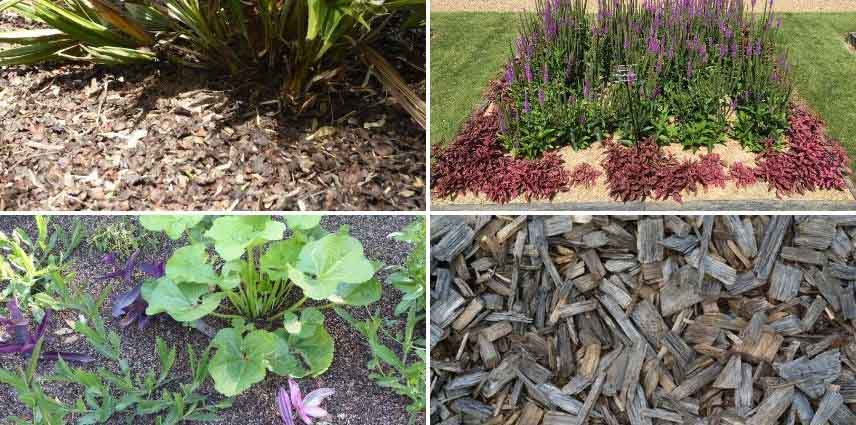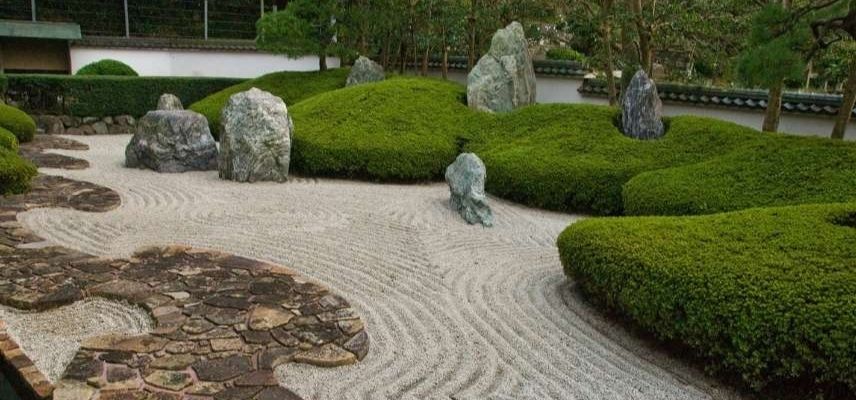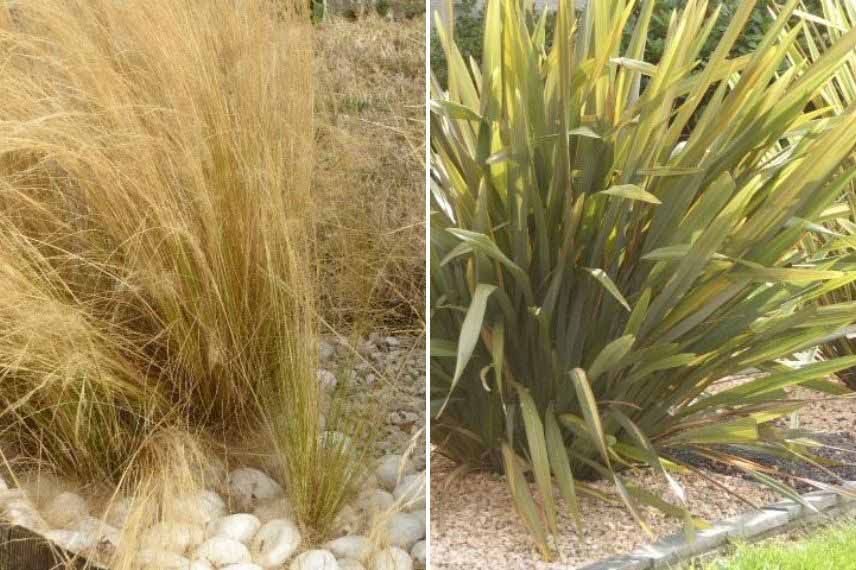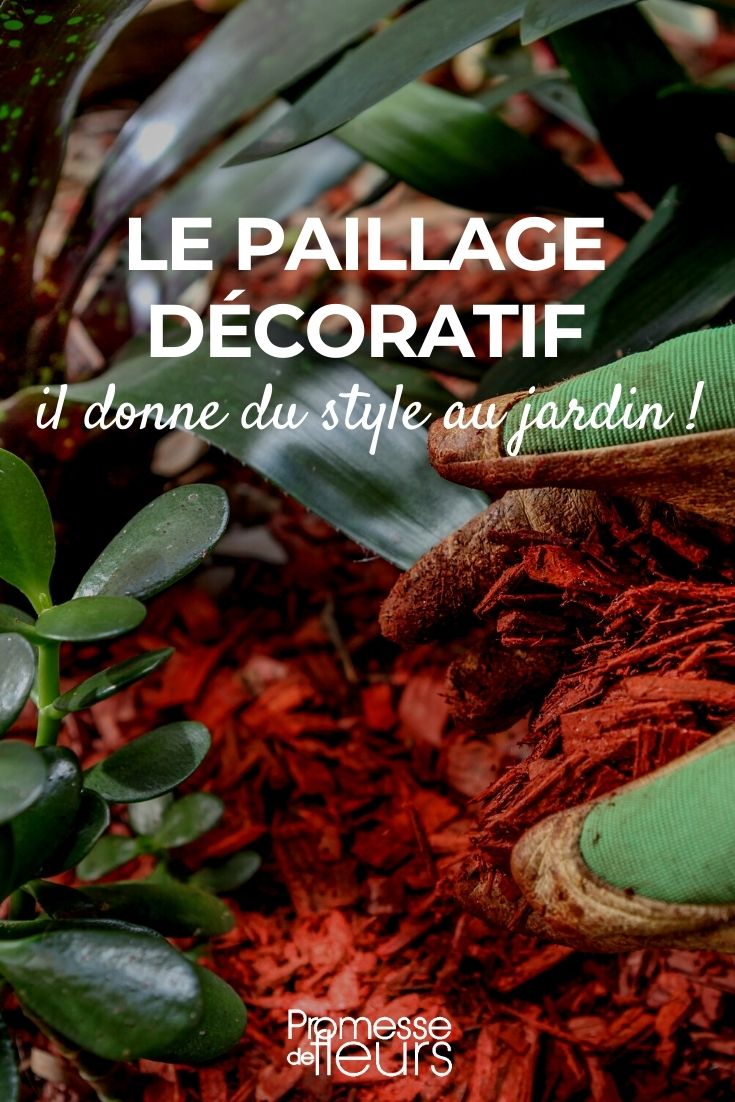
Decorative mulch: it adds style to the garden!
All our tips to help you choose wisely
Contents
Highly decorative as well as practical decorative mulch allows you to create beautiful colour contrasts and helps to showcase plants. It adds an aesthetic touch and gives character to your garden and can even harmonise outdoor spaces. This mulch is suitable for decorating all soils whether in ornamental gardens, in your borders, at the base of young trees and bushes, as mulch in vegetable gardens and even in planters.
It also offers many benefits: it reduces watering, keeps soil cool and retains moisture, slows the growth of weeds and can even feed the soil as it slowly decomposes. There are two families of mulch to beautify your garden or terrace in no time: the vegetal or organic mulch and mineral mulch. There is now a wide choice of mulches that are increasingly original, interesting and attractive.
Pine bark, hemp, wood chips or slate, whether organic or mineral in origin, discover the different decorative qualities of these mulches and our tips to help you make the right choice!
Plant-based mulches
These organic mulches are made from wood residues, more or less airy. 100% natural, biodegradable, they decompose naturally over time and enrich the soil by adding organic matter beneficial to plantings. Main drawback of mulches is that they need renewing more or less frequently. They come in different colours that enhance plant foliage and allow variety in garden design. Among different types of organic mulches, from most common to most unusual, are :
- Shavings (flax straw, hemp mulch, grasses..) : they consist of shredded plant stems. In twig form, they create contrasts thanks to their light colour. Their lifespan is about 2 years.
- Wood chips : they are made from maritime pine bark, more or less finely shredded. They are available in natural tones but also in coloured forms, red, yellow or brown if you like colour contrasts. Furthermore, the dyes used are of natural origin, harmless to humans, animals and plants. They form a slowly degrading mulch with a long lifespan and can stay in place for around 3 to 4 years.
- Cocoa shells : their attractive brown colour showcases plantings well; they decompose in about 1 year while nourishing the soil.
- Coconut chips : one of the most stable mulches over time and give an exotic touch to the garden.
- Buckwheat husks : a mulch particularly recommended for vegetable crops as slugs and snails tend to dislike its plant-based texture. Decomposition takes 2 to 3 years.
- Hazelnut shells : a particularly original, durable and attractive mulch with a warm colour.
Discover our full range of organic mulches and bark. For more information on mulching, also see our advice sheet: Mulching: Why? How?

Various mulches: cocoa shells, hemp shavings, buckwheat husks, wood chips
Read also
Create a Japanese or Zen gardenMineral mulches
Slate, pebbles, crushed brick, pumice, gravel, shale… All these rock-derived materials make up mineral mulch, another type of natural mulch. Compared with organic mulches, mineral mulches offer other interesting advantages in the garden: they stand the test of time, so are more durable because they do not decompose in soil, and they retain and release heat. In dry gardens, they protect plants’ collar from winter damp.
These are materials naturally frost-resistant, rotproof yet permeable to water and air, which stay in place for many years. Once installed, they require no maintenance and withstand weathering as well as wear and impact. Again, choice is wide. Red, orange, black, grey, pink, white… they come in various colours, sizes and shapes and each will bring its own style and effect to a planting. They allow very original compositions. The most common are:
- Slate flakes: they charm with their blue‑black colour and contemporary look. Their pH is slightly acidic, which will not suit all plants. Heavy, this mulch is naturally wind-resistant.
- Pumice: a natural mineral material of volcanic origin available in black or red. Porous, pumice is nevertheless heavy enough to stay in place on sloping ground and is therefore appreciated in windy areas.
- Crushed brick: a decorative and particularly durable mineral mulch.
- Expanded clay pebbles: these pretty little beads of expanded clay are lightweight, stable, recyclable and long‑lasting. Porous, they store water and release it to plants and, while widely used for container plants, they are also effective as a protective and decorative mulch at base of garden plants. They are available in black or red.

Slate flakes in herb bed and clay pebbles protecting Verbena bonariensis ‘Lollipop’
Discover our full range of mineral mulches.
Choose according to your plants
Depending on your planting, choose a mineral or organic mulch from these different materials. Some plants dislike mulch and the excess moisture it creates. This applies to Mediterranean plants such as cacti, succulents and yuccas. Avoid organic mulches for these plants, which prefer dry, poor soil. These succulents or rockery plants will favour a mineral material.
Organic mulches
They are suitable for most plants, except those from dry ground. Vegetable garden soil or beds are both protected and improved by organic mulches. They break down fairly quickly into humus, helping to feed the soil and promoting life of micro-organisms and insects beneficial to soil health.
Wood chips are very versatile and can be used everywhere: in planters, beds at the foot of your perennials, trees and bushes, on paths, in the vegetable garden…
Flax or hemp flakes will be perfect in flower beds and in the vegetable garden. Inexpensive, they cover large areas and will easily be incorporated into the soil at the end of the growing season. In the vegetable garden, they form a protective layer that isolates vegetables and fruit from the soil, thereby reducing risk of rot.
Hazelnut shell mulch is more suitable for tree and bush beds.
Buckwheat husk mulch is particularly recommended for vegetable crops as it feeds the soil while keeping slugs and snails away from crops.
Coconut chips are especially suitable for mulching poor, sandy soils and soilless culture (hydroculture) because their high absorption capacity always keeps moisture at a correct level at the base of plants. Spread them at the base of trees and bushes, small fruits and vines, bedding plants (annuals and biennials), roses, or perennials.
Mineral mulches
They are useful in gardens hosting plants from warm, dry climates such as alpine or Mediterranean flora, or even plants from desert media like agaves or cacti. Slate mulch is often used in heather soil beds at the foot of hydrangeas, rhododendrons, azaleas and camellias because it keeps the soil cool without altering soil acidity. Its blue colour highlights large pale rockery stones and enhances any mineral setting. In a dry garden, it can be used at the foot of cacti, succulents and yuccas…
Brick mulch is used at the base of bushes, perennials and for decorating rockeries. Because of its alkaline pH (8), it is not suitable for acidophilous plants (rhododendrons, camellias, azaleas…).

Choose mulch according to your plantings: natural bed here with buckwheat husks, tree base with wood chips, or contemporary mineral garden with a mix of slate, pebbles and pumice
Read also
How to create a gravel garden?Choose by garden style
In a Mediterranean garden
Mediterranean plants call for a restrained, mineral setting. Opt for mineral mulches that store heat during the day and release it at night, reducing water evaporation, which is ideal for rockeries of cacti or plants that particularly love heat and sun. Perfect for a no‑watering garden!
- Slate with its attractive, changing sheens,
- Pumice with its rough texture makes original, decorative groundcover,
- Les red clay balls will allow contrasts to be played up by adding a warm touch of colour.

Cacti or exotically inspired gardens are nicely enhanced by a slate mulch
In a natural garden
Naturalistic gardens combine the wild beauty of sturdy, flowering perennials while allowing a small wildlife, notably insects, to develop there as well as the soil’s microbial life. Choose plant‑based mulches instead :
- Wood chips, very decorative because of their lovely colour,
- pale linen or hemp flakes which, with their light hue, will add a contrasting touch to flower beds and dark foliage.
In this type of garden, plant mulches are ideal for limiting weed proliferation and avoiding the chore of weeding. Another advantage: they do not prevent plants from self‑seeding!

A light mulch such as pale hemp flakes is well suited to natural and country gardens
In a Japanese‑style garden
A garden of this style highlights relief, plant textures, the mineral element with stones and gravel, and water through cascades and ponds. The ground can be covered with white gravel but slate with its iridescent sheens, black clay balls or black pumice placed at the base of graphic plants such as Japanese maples, cloud‑pruned pines, rhododendrons, bamboos, flowering cherries and Japanese grasses will also be interesting materials.

An example of a Japanese‑style garden enhanced with white gravel
In a contemporary or mineral-style garden
Mineral mulches (slate, pumice, brick) contribute to good drainage and can release at night the heat stored during the day. Slate mulch is one of the favoured solutions among landscapers for creating a contemporary‑style garden. The slate’s bluish colour works wonderfully with grey foliage such as lavender or certain fescues, and with white flowers.

Choosing a mineral mulch harmonises perfectly with graphic, contemporary plants such as grasses or Phormiums
Our tips
Even though installing mulch at the base of your plants couldn’t be simpler, it’s still possible to get it wrong in terms of décor…
Here are missteps and tasteless choices to avoid :
- Avoid mixes of colours that are too harsh, unless you suddenly fancy a psychedelic garden or recreating the Jamaican flag… Golden rule: avoid mixing; aim for harmony of tones! Opt for a single hue or for pure contrasts (white/black) that will give your garden more style than a colourful cacophony
- Try to harmonise the exterior style of your house with that of your garden
- Mulches can be applied all year round, on perfectly weed-free soil
- Add fresh mulch regularly if you have chosen an organic mulch so aesthetic appearance endures over time
- Subscribe!
- Contents
































Comments